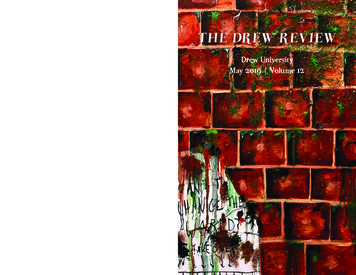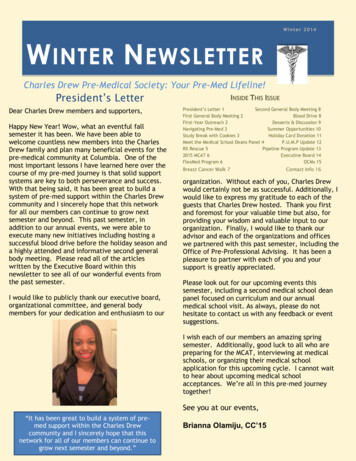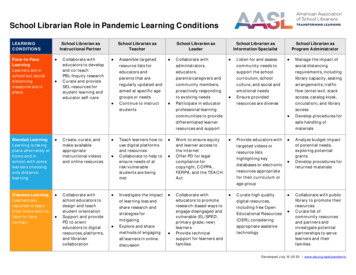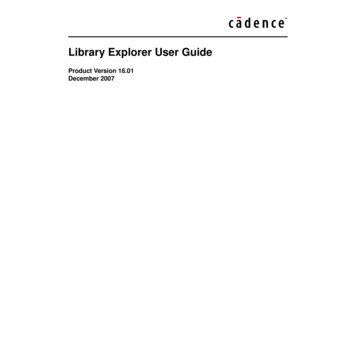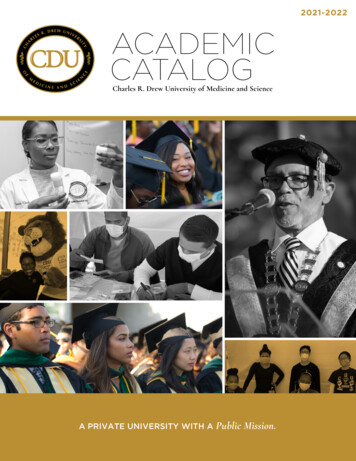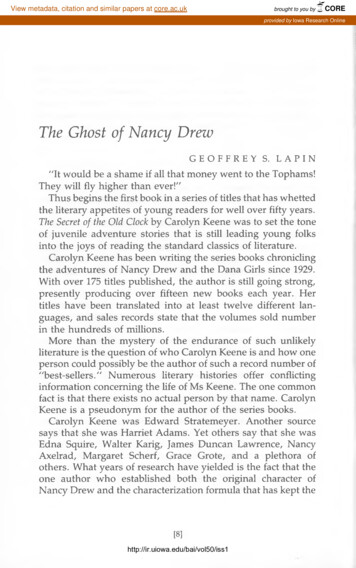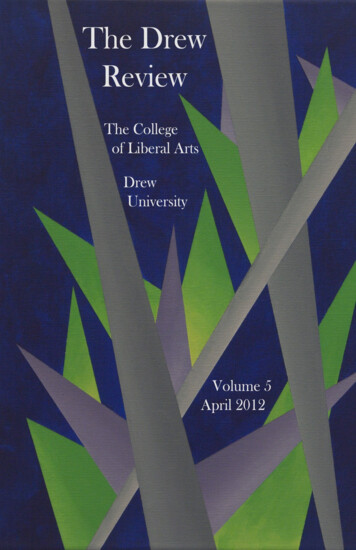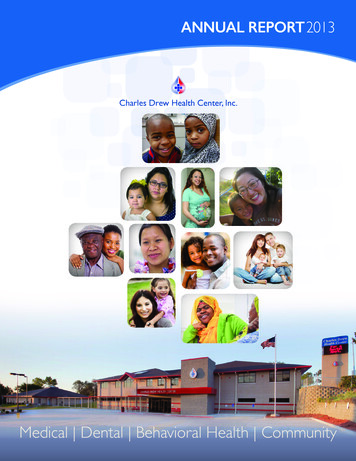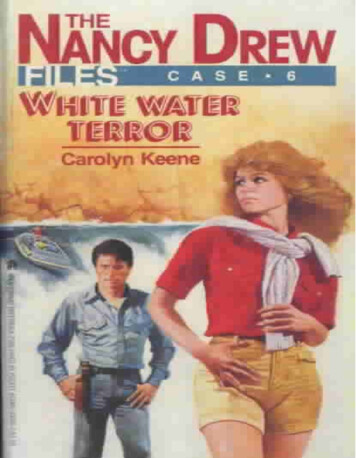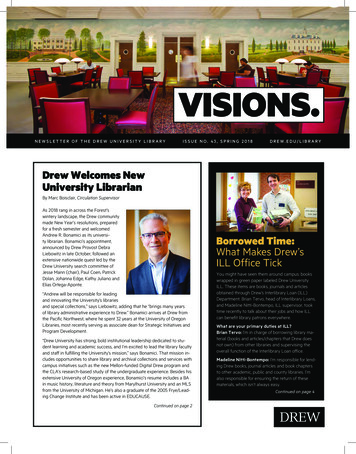
Transcription
VISIONS.NEWSLETTER OF THE DREW UNIVERSITY LIBRARYI S S U E N O. 4 3, S P R I N G 2 0 1 8DREW.EDU/LIBRARYDrew Welcomes NewUniversity LibrarianBy Marc Boisclair, Circulation SupervisorAs 2018 rang in across the Forest’swintery landscape, the Drew communitymade New Year’s resolutions, preparedfor a fresh semester and welcomedAndrew R. Bonamici as its university librarian. Bonamici’s appointment,announced by Drew Provost DebraLiebowitz in late October, followed anextensive nationwide quest led by theDrew University search committee ofJesse Mann (chair), Paul Coen, PatrickDolan, Johanna Edge, Kathy Juliano andElias Ortega-Aponte.Borrowed Time:What Makes Drew’sILL Office Tick“Andrew will be responsible for leadingand innovating the University’s librariesand special collections,” says Liebowitz, adding that he “brings many yearsof library administrative experience to Drew.” Bonamici arrives at Drew fromthe Pacific Northwest, where he spent 32 years at the University of OregonLibraries, most recently serving as associate dean for Strategic Initiatives andProgram Development.“Drew University has strong, bold institutional leadership dedicated to student learning and academic success, and I’m excited to lead the library facultyand staff in fulfilling the University’s mission,” says Bonamici. That mission includes opportunities to share library and archival collections and services withcampus initiatives such as the new Mellon-funded Digital Drew program andthe CLA’s research-based study of the undergraduate experience. Besides hisextensive University of Oregon experience, Bonamici’s resume includes a BAin music history, literature and theory from Marylhurst University and an MLSfrom the University of Michigan. He’s also a graduate of the 2005 Frye/Leading Change Institute and has been active in EDUCAUSE.Continued on page 2You might have seen them around campus: bookswrapped in green paper labeled Drew UniversityILL. These items are books, journals and articlesobtained through Drew’s Interlibrary Loan (ILL)Department. Brian Tervo, head of Interlibrary Loans,and Madeline Nitti-Bontempo, ILL supervisor, tooktime recently to talk about their jobs and how ILLcan benefit library patrons everywhere.What are your primary duties at ILL?Brian Tervo: I’m in charge of borrowing library material (books and articles/chapters that Drew doesnot own) from other libraries and supervising theoverall function of the Interlibrary Loan office.Madeline Nitti-Bontempo: I’m responsible for lending Drew books, journal articles and book chaptersto other academic, public and county libraries. I’malso responsible for ensuring the return of thesematerials, which isn’t always easy.Continued on page 4
VISIONS.University Librarian’s CornerWelcome to the spring 2018 issueof Visions. I’m writing this columnin week three of my role as Drew’snew university librarian. Thus farit’s been an exciting and enjoyablejourney, albeit one with a steeplearning curve. With that disclaimer, here are some thoughts aboutmy leadership role and goals forthe next few months.When Drew Provost Debra Leibowitz invited me to come onboard last fall, her first priority was that I shape and implement thelibrary’s vision, mission and goals to be in concert with those of theUniversity. Most good plans start with good people, so I’ve beengetting to know Drew’s academic and administrative leaders, plusthe faculty and staff of the libraries, listening to their views on theeducational and social experience at Drew.I envision the library as a 21st-century academic commons, a welcoming place that simultaneously serves as a physical, virtual andintellectual home for the entire Drew community, building and contributing to the University’s success. There are several componentsthat come together in this vision: The Physical Commons. The library buildings and servicesdelivered on their premises—reference, instruction, circulation,interlibrary loan, consulting and tutoring, among them. Intellectual Commons. We’ll continue to host and co-sponsorlectures, workshops, work-in-progress events and interest groups.A 21st-century academic commons also requires an expertlyskilled, highly motivated library faculty and staff. We’ll invest indevelopment and training opportunities to provide a truly dynamic,networked environment.My priorities also include the cultivation and enhancement ofdonor relations in collaboration with Drew University Advancement,including private philanthropy, corporate and foundation support,and grants. Investing in libraries and archives benefits all of Drew,and offers compelling opportunities for donors and friends.This issue of Visions reflects the library’s wide range of services,collections, events and people, with stories on our Interlibrary Loanservices; a Q&A on film with Professor Shakti Jaising; informationabout the launch of the library’s redesigned website and profiles ofnew employees and student staffers.This is a truly exciting time to lead the Drew University Library.I’m grateful to Kathy Juliano for her service as interim universitylibrarian and my orientation to the library, and for the warmwelcome of library faculty and staff.We hope your reading encourages you to visit us at the library,either on campus or online at drew.edu/library. Drew Library Collections. Our vast collection of print, media andelectronic materials. Virtual and Digital Services. The libraries are a hub for digitalscholarship support, digitization of unique Drew holdings, institutional repositories and Open Access publishing.Andrew BonamiciUniversity LibrarianNEW UNIVERSITY LIBRARIANContinued from page 1Before embarking on any major library projects, Bonamici’s first priorities have been getting toknow his new home by visiting Drew’s various schools, departments and programs and holdingface-to-face meetings with key academic and administrative leaders. He’s spent considerable timein particular with faculty and staff members at the Drew libraries. “I want to learn more about thecollections, which are of remarkable quality and depth, and the ways the collections are used ininstruction and research,” he says. He’s also keen on connecting with other academic libraries inthe New Jersey region, not to mention soaking up Drew life by attending music and theater performances and Ranger games.Bonamici’s biggest challenge thus far: the drive from Eugene, Oregon, to Madison. “Fortunately, theweather in late November was excellent all the way across the country,” he says. “Now that we’rethrough the initial move-in phase, my wife, Beth, and I are adjusting nicely. Everyone has been verywelcoming, not only on campus but around the community.”2 Drew UniversityVISIONS.Andrew BonamiciUniversity LibrarianDrew University LibraryEditor: Marc BoisclairAssociate Editor: Kathy JulianoOnline Edition: Jennifer HeiseA complete online archive of pastissues of Visions can be viewed atdrew.edu/library/visions.
Shakti Jaising on the History, Social Valueand Sheer Pleasure of MoviesBy Marc Boisclair, Circulation SupervisorWhile growing up in Bombay (nowMumbai), India, what was it aboutseeing movies that thrilled you?We went to the movies often—both Hindiand English films. (My mother is an unofficial expert on Hindi cinema, and my fatherloved American movies.) That collectiveexperience remains something I love,especially watching movies in the cinema.What value do films convey as bothteaching tools and course content?Films tend to elicit visceral or embodiedresponses from most of us, and this, in part,is what makes them invaluable as tools forteaching and social activism. A good filmcan get students actively and energeticallyinvolved in talking and thinking about atopic or in analyzing the process they wentthrough as they watched.How do books and films complementeach other as instructional material?Films can get students to start to careabout something, to “wake up” to a set ofissues or ideas. Written material, in conjunction with film, then compels studentsto slow down, reflect, analyze and putthings in historical context.How critical is a good film collectionto a university library?Absolutely crucial, for the reasonsmentioned above and as an invaluablecomplement to written material.What films in the Drew Library collection do you consistently return to forclass work?There are so many. Chaplin’s ModernTimes (1936), for example, is a fantasticfilm—so skillfully made, incredibly funnyand terribly moving, but also an astutecommentary on industrial capitalism andmodernity. I use it regularly in Introductionto Film Analysis, where we analyze itsmise-en-scene and editing techniques.What films would you like to see addedto the Drew collection?Many of the films I use in class nowadaysare on digital databases (e.g., Swank andKanopy), excellent and invaluable resources to which the university subscribes. Aslong as the school continues to offer access to them, students will be exposed to avast array of films from all over the world.Movie versions of famous books have ahit-and-miss history. Is there one thatreally rocks you?Luchino Visconti’s adaptation of ThomasMann’s Death in Venice (1971). It’s anexcellent adaptation and a wonderful filmin its own right.What movies would you recommendyour students see for film theory andanalysis?Asghar Farhadi’s A Separation (2012),which is bound to leave you thinking aboutyourself, social relations and class relations,and Yasujiro Ozu’s Tokyo Story (1953), avery moving portrait of social and familyrelations in an increasingly modernizing,capitalist society. Both have universalappeal, compelling you to think aboutyourself in relation to social forces, to seeyourself as a product of a social system.What does the history of film teachus about the evolution of society ingeneral?Cinema all over the world has functionedas a quintessential archive of the 20thcentury, of contemporary capitalism andmodernity. Films like Modern Times andTokyo Story either explicitly or implicitlyilluminate how various societies respond tothese forces.How can good films affect audiences?One capacity of cinema that excites meis its potential as a tool for social engagement and activism. In recent semesters,my students have watched Central ParkFive (2012) and 13th (2016)—two fantasticdocumentaries about institutionalizedracism in the U.S. criminal justice system.Several students have remarked abouthow watching these films made them bothdevelop an analysis of the problem andbecome inspired to fight for justice.Who’s a favorite director of yours?I really like Ken Loach, a British directorwho’s made a lot of excellent, sociallyengaged films since the 1960s. I, DanielBlake (2016), about the collapse of theBritish welfare state and how it’s affectingordinary people, is absolutely fantastic.What movie have you seen lately thatstands out for its quality and message?Definitely Lady Bird—the writing is excellent;the direction and acting are wonderful. Youreally get close to an entire community(Sacramento, California) and way of life,and the struggles of people to survive.Your favorite movie-watching mode?In a theater, with my partner.drew.edu/library3
VISIONS.ILL Continued from page 1Describe your typical workday.MNB: The first thing I do is download bookand journal article requests so that ourstudent assistants can pull the books andpackage them up for shipping, as well as scanarticles to be sent to the requesting libraries.I then process renewals and send emails tolibraries that borrowed materials that are nowoverdue.BT: I process borrowing requests that ourDrew patrons have submitted through ILLiad(soon to be Tipasa). I usually process loanrequests first, sending them to our localconsortia libraries before requesting frominstitutions farther away. Then I’ll processarticle/chapter requests. We also providedocument delivery services for remote userswho need articles/chapters from the Drewlibrary collection.What’s your biggest challenge?BT: Obtaining library material quickly,because patrons often need their materialyesterday.MNB: I cannot fill certain requests for journalarticles because the publisher puts embargoson the full-text access, which can range fromone to six years. This is especially frustratingwhen it involves scientific or medical journals,information that could be critical to a studentor faculty member’s research.Who uses ILL services the most?BT: In order of the number of requests: undergraduates, graduate students, then facultyand staff.How many requests do you get in acalendar year?BT: Last academic year we had 8,240 totalrequests: 3,345 were for lending, 3,622 forborrowing and 1,273 for document delivery.What are most ILL books used for?MNB: For research and classroom assignments. I doubt if anyone would considerDifferential Dynamical Systems a good beachread.What’s the greatest number of requestsyou’ve had from one person in a year?BT: For the last academic year it was 108.Is there an aspect of ILL that wouldsurprise people?MNB: If a book mysteriously ends up in ourbook drop and it’s not ours or a book Drewborrowed from another library, we mail itback to its home as a courtesy.Why are ILL services still important in amodern-day library?BT: Not everything is available for free online.Students and faculty still need access to printbooks and to articles from journals that Drewdoes not subscribe to.How much time does it take to receive anILL book?BT: Books take an average of eight days,while articles/chapters take two days.MNB: Also, if the book was just published itcan take longer to find a copy, as many libraries do not loan books recently published.How far away have books and scans comefrom and gone to via the Drew ILL office?BT: Throughout the world. While we get mostbooks from other U.S. libraries, we do sometimes need to request material from Europe,Asia, etc. I would guess most of our international requests come from Europe.MNB: I’ve loaned books to libraries as faraway as Australia, South Korea, Denmark andCanada. I send articles all over the world.Recently, I’ve been getting numerousrequests from the American University ofSharjah in the United Arab Emirates.What’s your favorite thing about workingin ILL?BT: Locating hard-to-find material for apatron in need.MNB: I get a great deal of satisfaction fillinga request when Drew is the only library thatowns the item or all other libraries on thelending string were unable to fill the requestbut Drew can. I also enjoy the interaction withthe students and faculty.What We’re ReadingBy Yanira Ramirez, Catalog AssociateSula, by Toni Morrison (2004)Drew call number: PS3563 .08749 S8 2004Drew Library location: Level C, circulating stacks“There is nothing more dangerous than theordinary lives we lead.” When I look back at myundergraduate years, this offhand gem of wisdom from a former professor stands out amidthe blur of midterms, papers and long nightsreading romance books when I really shouldhave been studying. From that point forward,my reading life took shape. I wanted to learnabout the ordinary lives people lead and whythose lives could be potentially dangerous.This is where Sula by Toni Morrison comes in.It’s a rich, complex novel that traces the lives oftwo black women born in the close-knit, small4 Drew Universitytown of Bottom, Ohio. Much of Morrison’s vastbody of work captures the costs of being ablack person in America, and this book is noexception. In Sula, she brilliantly describes theordinary details of her characters’ daily lives:their close friendship; a sudden, accidentaldeath; their separation and confrontation; andthe redemption of their eventual reconciliation.It’s the kind of storytelling that’s intimate, intense and makes some people uncomfortable.However, this may be precisely the time formany Americans to confront, if not embrace,discomfiting realities.Part of Morrison’s genius is her knack forforcing people to recognize how the lives ofothers play out so differently and often withmore difficulty than our own. Sula states “thereal hell of Hell isthat it is forever.”It is this nuggetof truth that suggests the dangersof being blackin America. Thepainfully harshtruth for Morrison’s characters,as well as formany Americanstoday, is thatdeath doesn’tnecessarily rescue them when we want theirmisery to end. The dangerous thing about lifeis that it continues.
Student SnapshotsThe staffs of the library and the Instructional Technology Department rely on the dedication of many student staffers to keep our operationsrunning smoothly. Here are snapshots of four of our hardworking, service-oriented students.Sharif KhanYear: JuniorStudying: economics; business;biologyJob Title: Subject tutor, Center forAcademic ExcellenceHome: Hudson and Harlem, New YorkDuties: I tutor five subjects at the CAE: micro- and macroeconomics, financial and managerial accounting, and public speech.Most satisfying part of the job: Providing hope, education andmotivation to students. It’s a great feeling when professors comeback to me to say how much better their students are doing.Skills learned: Becoming professional in all settings, includingemails; following up and creating reports.In-house getaway: Loren Kleinman’s office in the CAE. She letsme just sit and have conversations about our day and work.Notable checkout: I enjoy magazines the most.Post-Drew goals: My primary goal is to become a physician’sassistant in a hospital. My secondary plan is to work on Wall Street.By age 25 I plan to be married, employed and ready to put a downpayment on my first house.Diana LeeYear: SophomoreStudying: Economics and GermanJob Title: Circulation studentassistant/supervisorHome: Fort Lee, New JerseyDuties: Shelving, horizontal checking, shelf reading, helping patrons.Most satisfying part of the job: Checking out books or discharging,because I like to do scanning (it’s that beeping, barcode thing, like we seeat supermarkets).Skills learned: Answering the phone, conversing with strangers, improving my social skills.In-house getaway: Level A, Room LC16. It’s big, has two white boardsand markers, is open to the public and has tons of outlets to charge anyelectronic device. It’s the best place for group studies, especially if you’rea loud bunch.Notable checkout: I’ve only gotten as far as checking out study roomsand markers.Post-Drew goals: Hopefully I can be in a line of work that focuses oninternational business/economics, because I like to submerge myself intodifferent cultures and have the opportunity to travel.Emily RosalesYear: JuniorStudying: Theatre arts andpsychologyJob Title: Circulation studentassistantHome: Philippines and Viet NamDuties: Shelf reading, shelving books, helping out patrons andworking the front desk.Most satisfying part of the job: Knowing almost everythingabout the library and how things work within it. I can now easilyuse that knowledge to my advantage as well as to help friendsand others.Skills learned: I’ve learned to navigate the library really well, toquickly find books from anywhere and help others do the same.In-house getaway: The benches outside the main library doors.Notable library book/film: Books about Asian-American playwrights and their works. I didn’t know a lot of Asian-Americanplaywrights and the plays they’ve written, aside from the onesthat were really famous.Post-Drew goals: I’d love to be a part of a theater company—one whose mission statement really resonates with me—orworking on any theater production, ideally in New York.Rebecca Van HornYear: Doctoral third yearStudying: Irish history and cultureJob Title: Research help desk assistantHome: Kittatinny Lake, New JerseyDuties: I answer phone inquiries, aid with printing issues and help CLA,Caspersen and Theological students find articles, journals and books fortheir unique research projects.Most satisfying part of the job: I’ve learned a lot about topics I wouldotherwise have had very little familiarity with.Skills learned: I’ve become much more familiar with the Dewey Decimaland Library of Congress classification systems, which is helpful to mewhen I look for books for my own project.In-house getaway: My Baldwin carrel—my desk is quiet, cozy andsecluded.Notable library book/film: One of my personal favorites is RalphEllison’s Invisible Man. It’s a powerful statement on race, politicaleconomy and gender, and reveals new insights every time I read it.Post-Drew goals: A traditional faculty position, and work in otheron-campus administrative positions or in the nonprofit sector.drew.edu/library5
VISIONS.Face Value: Drew Library Online Debuts a Sharp PersonaBy Jennifer Heise, Reference Librarian and Coordinator of Digital ServicesThis January marked the debut of a newlook for the library’s online presence—drew.edu/library—and according to ourusers, it’s “beautiful and easy to navigate.”The site’s crisp, user-friendly revisioncomes thanks to the hard work of thelibrary’s web content team (Jennifer Heise,the team leader, as well as Rick Mikulski,Verna Holcomb, Brian Shetler and KathyJuliano), along with assistance from DrewUniversity Communications and active input from all library departments. The newsite offers better access to online resources and information, with a simpler, cleanerstructure; better graphics and photos;a librarian chat window on every pageand specialized pages for alumni, faculty,Theological and Caspersen students.To ensure that the improved visualsmatch up with the site’s improved func-tionality, the content team conductedusability analyses of both the old site—looking for things to improve—and later,the new site design. Work started in July2017 in a training session with JustinJackson and Neil McIntyre from DrewCommunications. The team adopted atight timeline: just six months to recreateand redesign the whole site.Using a draft of the proposed site, thecontent team held a user testing/observation event in November 2017where about 90 members of the Drewcommunity, fortified by free coffee anddoughnuts, explored the new pages.Feedback was critical in terms of whetherthe test group could access key information and services easily and quickly.Happily, most users found the beta version of the new site easier to use, and theircomments helped us to improve the site.In MemoriamNorman Tomlinson (1927–2017)Drew University was sad to learn of the passing of Norman Tomlinsonon December 7, 2017. Tomlinson was a great supporter of the libraryand made a major impact on the long-term storage of Drew’s rarebooks collection. While the whole library benefited from Tomlinson’scontributions, his generosity, kindness and support are woven into thevery fabric of the library’s Special Collections in particular. Tomlinson’s gift in support of the construction of a new home for our rarebooks and other special collections changed the way that the libraryserves the public and increased access to materials for scholars andstudents.In addition to his generous donations, Tomlinson gave willinglyfrom his personal collection of rare books and valuable materials.The library is both fortunate and proud to house many of his mosttreasured items in its Special Collections. From first editions of LordByron and complete sets of works by Winston Churchill to the beautiful, bountiful Walt Whitman collection, Tomlinson’s legacy extendsfrom the building to the bookshelf. We are privileged to have knownNorman Tomlinson and shared in his passion for literature, rare booksand scholarship. His kindness and incredible generosity will not beforgotten.6 Drew UniversitySince the launch, reaction to the newdesign has been overwhelmingly positive.“It’s better organized, more aestheticallypleasing and makes it possible to exploreother aspects of the site that were harderto locate in previous iterations,” says oneuser. Another was pleased to find everything needed on the first page, minusthe hassle of searching for informationendlessly. As the site team developsnew content, it will continue to add andimprove features.“Libraries—and their websites—serve ashubs for discovery, access to content andan opportunity to interact with experts,”says Drew’s new University LibrarianAndrew Bonamici. “The improved userexperience and clear navigation to Drew’smain pages affirms our library’s dedication to the shared enterprise of academicsuccess.”Professional NewsBrian Shetler, head of special collectionsand university archives and Methodistlibrarian, presented “Presenting Chaucerto the Reader: The Canterbury Tales fromCaxton to Kelmscott, 1477–1896,” as partof the History and Culture Colloquia inDecember 2017.Jesse D. Mann, theological librarian,completed his MLIS degree at Rutgers inDecember 2017. In his final semester, hereceived the Distinguished Library andInformation Science Department Award.Dr. Mann was also recently elected toserve as the faculty representative toDrew’s Theological Student Association.Margery Ashmun, reference librarian,science specialty, presented “A NobelPrize and the Library: Forming Partnerships to Highlight the Good News,” duringthe morning session of Lightning Talks atthe Virtual Academic Library Environment(VALE) Conference, held at RutgersUniversity in New Brunswick, New Jersey in January 2018.
Recent GiftsNew to the LibrariesThe Library gratefully acknowledges the following gifts.Financial SupportDr. Hermione de AlmeidaDr. Lucille F. BeckerDr. Patti M. BeckerDr. Sarah D. B. BlairJeffrey I. BloomfieldAndrew BonamiciKatherine G. BrownCarol ChildsDr. Linda E. & Mr. Frank ConnorsLessie Culmer-NierDr. Rose Ellen DunnDr. Epsey C. FarrellJoseph J. Harzbecker Jr.Patrick A. HickeyFred J. HrinukThe Jacob Landau InstituteAmanda B. JohnsonApril L. KaneDr. Flo KeyesDr. Edwina & Terry LawlerSusan H. LivingstonLucy MarksJohn G. McEllhenneyDr. G. Kurt PiehlerDr. June SchleuterDr. Andrew & Mrs. Dorothy ScrimgeourBishop John S. SpongDr. Leslie SproutDr. Arturo A. ValenzuelaDr. Donald E. WeatherbeeEmma Lee YuGifts in KindSusan V.P.W. BynumDr. Patricia CampbellDr. Sloane Drayson-KniggeJeffrey EgerWendy EricksonJoan GoodellDr. Deborah HessDr. Hildegard Gruenbaum KatzLeonard A. LaBarbieraMarsha MannsBert MyersRev. R. Bruce & Mrs. Karolyn PoynterBruce ReynoldsDr. Raul RosalesSociety of Biblical LiteratureDrs. David & Deirdre StamDr. William & Mrs. Mary Ann StrokerRui Antonio Homem da Cruz TrindadeGifts in Kind to the Methodist LibraryAndrew CattanoMargot DudewiczCatherine HendricksMcTyeire Alumnae AssociationJohn TrisGaithree (Usha) GaneshIn December 2017 Usha Ganeshjoined the main library staffas a new weekend circulationsupervisor. She comes to Drewwith a Bachelor of BusinessAdministration from Iowa StateUniversity and after working 18 years at the EsteeLauder Companies in New Jersey in accounting,financial analysis and as finance manager forindirect procurement in New York City. Ganesh’sresponsibilities include training and supervising thecirculation department’s student staff and assistinglibrary patrons.Candace ReillyDrew alumna Candace Reillyjoined the university’s librariesin January 2018 as MethodistLibrary and special collectionsassociate. She has a BA in arthistory from Drew, an MA inmedieval studies from the University of York and isa doctoral candidate in history of art from the sameinstitution. Her resume includes work at the NewYork Public Library, Yeshiva University Museumand James Cummins Bookseller. Reilly also teachesHistory of Art at Raritan Valley Community College.Friends of the LibraryEnclosed is my/our gift to theDrew University Library at the level of:o Friend. 50o Donor. 100o Sponsor. 500o Patron. 1,000o Benefactor. 5,000A check for , payable to“Drew University Library,” is enclosed.o Please charge to:o VISA o A. merican Express o MasterCardAccount numberExpiration dateName (please print)Mailing addressCity/State/ZIPTelephonePlease return this form to:Friends of the LibraryDrew University LibraryDrew UniversityMadison, NJ 07940SignatureFor more information, please call the library at 973.408.3471. Donations are tax deductible to the fullest extent allowed by law.drew.edu/library7
VISIONS.Library EventsOUT OF THE VAULT SERIESLIBRARY EXHIBITWilson Reading Room, Methodist CenterHere Be Dragons: A Look atRare and Historical MapsMusic in the Archives: Hymns,Harmonies and High NotesTuesday, March 13, 2018 4 p.m.Tuesday, April 3, 2018 4 p.m.This event will showcase some of thestrangest and most beautiful imagesin Drew’s rare book collections, from15th-century maps of the world to detailedbattle maps from the Civil War. Highlighting more than 500 years of map-making,we’ll offer insight into how the world wasseen by people at different points of history, including the dragons and monstersthat roamed unknown lands.Drew University has one of the largest collections of hymnals in the world, numberingmore than 6,000, some of which will be ondisplay for this event. Come see highlightsfrom 300 years of hymn-book history, aswell as our oldest (and largest) music book: amassive choral tome from the 15th century.CONVERSATIONS ON COLLECTINGHosted by the Friends of the Library Methodist Center LobbyThe History & Collectingof Board GamesDREW PROFESSOR ALEX DE VOOGTTuesday, April 17, 2018 4 p.m.Co-sponsored by the Gaming Club, this eventwill feature a talk about the history of oneof America’s favorite family pastimes. DrewProfessor Alex de Voogt, co-author of Movesin Mind: The Psychology of Board Games, willshare stories about his own collection. Everyone will be invited to play board games bothnew and old. Refreshments will be provided.LIBRARY CONTACTS.Call: 973.408.3486Email: reference@drew.eduOnline: drew.edu/libraryIndexing the Leaves:Zuck Botanical Books CollectionCurated by Karen AzoulayJanuary 22–March 16, 2018Methodist Center and Main LibraryThe beauty and art of botanical books
2 Drew University VISIONS. drew.edu/library 3 Welcome to the spring 2018 issue of Visions. I'm writing this column in week three of my role as Drew's new university librarian. Thus far it's been an exciting and enjoyable journey, albeit one with a steep learning curve. With that disclaim-er, here are some thoughts about

